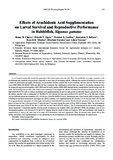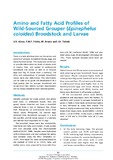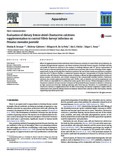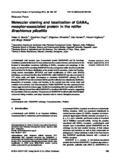Effects of arachidonic acid supplementation on larval and survival and reproductive performance in rabbitfish, Siganus guttatus

Tingnan/
Request this document
Petsa
2007May-akda
Page views
384Metadata
Ipakita ang buong tala ng item
Share
Abstract
Fry of tropical marine fish needed for aquaculture still comes mostly from the wild. Thus, fry availability is a major constraint in the development and extension of aquaculture, especially in rural areas of developing regions. Although the mission of hatcheries is to provide a stable fry production and supply for farmers, fry production remains variable due to poor fecundity and low survival. For the last four years (2002-2005), SEAFDEC/AQD and JIRCAS have conducted the collaborative project that was aimed at developing advanced diets for improving egg production/quality (2002-2005) and larvae/fry quality (2004-2005) through dietary manipulation. Larval rearing tests: In 2005, larval rearing tests (4 trials with rotifers) were conducted to investigate the effects of enriched-live food (4treatments: low (CS) and high (DHAPS) HUFA with or without arachidonic acid supplementation) on survival and growth in rabbitfish Sigunus guttatus fry. Fry fed the rotifers enriched with a combination of DHAPS+5% ArA showed the best survival (44.4±4.5% for D17 fry in the 4th trial).Growth was not different among the treatments (CS, CS+5% ArA, DHAPS, DHPS+5% ArA). Broodstock tests: From March, 2005 to January,2006, a feeding test has been conducted to investigate the effects of dietary ArA supplementation (0% for diet 1, 0.3% for diet 2 and 0.6% for diet 3) on egg production and quality of wild-caught and hatchery-bled rabbitfish broodstock. The broodstock spawned 13 times for diet1 (six pairs), 14 times for diet 2 (five pairs) and 17 times for diet 3 (six pairs) during the period of May 2005 to January, 2006. The total numbers ofhatched-larvae were 3,818 x 103 for diet 1, 4,391 x 103 for diet 2 and 4,597 x 103 for diet 3. The % of normal larvae did not differ among the dietary treatments. Considering together with the results of mangrove red snapper (2003) and rabbitfish (2004), the optimum level of ArA incorporation appears to be between 0.5% and 0.7%. Judging from the results of fatty acid analysis, DHA and arachidonic acid should be supplemented to diets at the same time as to make DHA/arachidonic acid ratio appropriate. Thus, the present study clearly shows that dietary arachidonic acid supplementation is very promising for the development of fry production technologies in tropical areas.
Suggested Citation
Chavez, D. R., Ogata, H. Y., Garibay, E. S., Sollesta, H. T., Tibubos, K. R., Furuita, H., & Suloma, A. (2007). Effects of arachidonic acid supplementation on larval and survival and reproductive performance in rabbitfish, Siganus guttatus. In K. Nakamura (Ed.), Sustainable Production Systems of Aquatic Animals in Brackish Mangrove Areas (JIRCAS Working Report No. 56) (pp. 113–120). Tsukuba, Ibaraki, Japan: Japan International Research Center for Agricultural Sciences.
Paksa
Mga koleksyon
Related items
Showing items related by title, author, creator and subject.
-
Amino and fatty acid profiles of wild-sourced grouper (Epinephelus coioides) broodstock and larvae
Alava, Veronica R.; Priolo, Flora Mae P.; Toledo, Joebert D.; Rodriguez Jr., Jesus C.; Quinitio, Gerald F.; Sa-an, Analyn C.; de la Peña, Milagros R.; Caturao, Romeo D. (Australian Centre for International Agricultural Research, 2004)This study was undertaken to provide information on the levels of amino acids in the muscle, liver and gonad of wild-sourced broodstock and larvae, as well as in neurula eggs and day 35 larvae from a hatchery. The fatty ... -
Evaluation of dietary freeze-dried Chaetoceros calcitrans supplementation to control Vibrio harveyi infection on Penaeus monodon juvenile
Seraspe, Ebonia B.; Gabotero, Shirleny; de la Peña, Milagros R.; Pahila, Ida G.; Amar, Edgar (Elsevier, 2014)Effects of supplementation of diets with freeze-dried Chaetoceros calcitrans to control Vibrio harveyi infection are evaluated through immune responses, and disease resistance of juvenile Penaeus monodon. Total lipid and ... -
Molecular cloning and localization of GABAA receptor-associated protein in the rotifer Brachionus plicatilis
Marcial, Helen S.; Suga, Koushirou; Kinoshita, Shigaheru; Kaneko, Gen; Hagiwara, Atsushi; Watabe, Shugo (Wiley-VCH Verlag, 2014)γ-Aminobutyric acid receptor type A-associated protein (GABARAP) and its homologs constitute a protein family found in many eukaryotes from yeast to human, and are known to be involved in intracellular membrane trafficking ...




